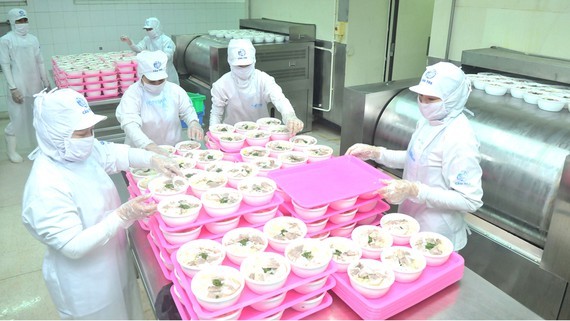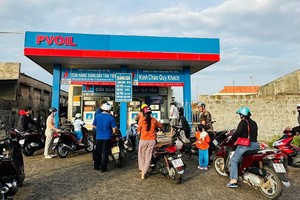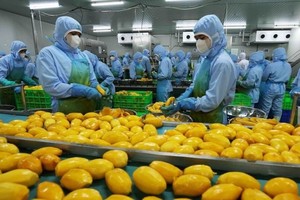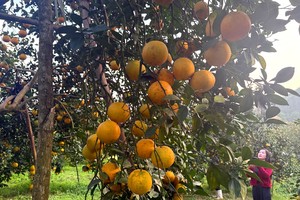
According to economic experts, several reasons made the processing industry of Vietnam attractive to FDI capital. This field has great potential but has been developing slowly for a long time. Currently, Vietnam is among the five breadbaskets of the world thanks to its diverse and plentiful supply of agricultural products, seafood, and aquatic products. Last year, the total production of aquatic products was estimated at 8.2 million tons, an increase of 5.6 percent compared to the previous year.
Pork production was estimated at 3.3 million tons. As for fruits, statistics showed that orange production reached 960,900 tons, an increase of 12.4 percent compared to the previous year; pomelo production 779,300 tons, an increase of 18.2 percent; mango production 814,800 tons, an increase of 2.9 percent; dragon fruit production more than 1.2 million tons, an increase of 15 percent. Especially, Vietnam is also among the largest rice exporters in the world. Vietnam’s ST25 rice variety has recently received the World’s Best Rice award. This has started to increase the value and global consumers’ awareness of Vietnamese agricultural, seafood, and aquatic products in the global market.
Domestically, many farming households that received technical assistance close to international quality standards have shifted farming towards reducing the production but increasing the quality and value, contributing to the stabilization of the supply of domestic raw materials for processing enterprises. For instance, farmers have cultivated longan and lychee fruits under the VietGAP and GlobalGAP standards so although lychee production merely reached 272,000 tons, down 30.1 percent, and longan production nearly touched 508,000 tons, down 6.6 percent, their export values were two times higher compared to the same period in the previous year.
Ms. Ly Kim Chi, Chairwoman of the Food and Foodstuffs Association of Ho Chi Minh City, said that the massive landing of foreign enterprises and their acquisition strategy, of which there were many processing enterprises from South Korea, has been pushing domestic enterprises into a fierce competition. In fact, many domestic enterprises were forced to merge with foreign enterprises because they could not compete. For instance, the South Korean conglomerate CJ Group bought the controlling stake in Minh Dat Food Company, and Cau Tre Export Goods Processing Joint Stock Company. Moreover, some domestic processed food and beverage brands have also fallen into the hands of foreign companies, namely Kinh Do, Bibica, Sabeco, and Tribeco.
Many domestic enterprises said that as they could not compete with foreign ones, they had to sell their stake to them though they did not want to. Foreign enterprises not only have large investment capital but also receive huge support from foreign distribution channels. In the strategy of gaining market share, there is usually a close collaboration between manufacturers and distributors to carry out the competitive pricing policy. In addition, they also have advantages in brand history and the preference for foreign-made products of domestic consumers.
According to Ms. Ly Kim Chi, for domestic enterprises to withstand amid the context of a cutthroat competition as currently, on one hand, they need to actively upgrade technology and production scale. On the other hand, authorities need to slake the thirst for capital of enterprises. More importantly, the domestic distribution channel needs to be developed to lead and create favorable conditions for the spread of Vietnamese products.
Sharing the same point of view, Mr. Nguyen Ngoc Hoa, Chairman of the Member’s Council of the Ho Chi Minh City Finance and Investment State-owned Company, said that the company will collaborate with departments to look for and approach enterprises with financial needs to upgrade their production technology. Thereby, it will build solutions to invest and use effectively loans. Enterprises in the key sectors of the city will be given priority in accessing these loans. On the contrary, enterprises also need to be more active in accessing loans to reduce the distance from borrowing demand to actual disbursed capital. Vietnamese enterprises need to effectivelyimplement financial transparency, and production activities, and have sustainable development strategies.
Pork production was estimated at 3.3 million tons. As for fruits, statistics showed that orange production reached 960,900 tons, an increase of 12.4 percent compared to the previous year; pomelo production 779,300 tons, an increase of 18.2 percent; mango production 814,800 tons, an increase of 2.9 percent; dragon fruit production more than 1.2 million tons, an increase of 15 percent. Especially, Vietnam is also among the largest rice exporters in the world. Vietnam’s ST25 rice variety has recently received the World’s Best Rice award. This has started to increase the value and global consumers’ awareness of Vietnamese agricultural, seafood, and aquatic products in the global market.
Domestically, many farming households that received technical assistance close to international quality standards have shifted farming towards reducing the production but increasing the quality and value, contributing to the stabilization of the supply of domestic raw materials for processing enterprises. For instance, farmers have cultivated longan and lychee fruits under the VietGAP and GlobalGAP standards so although lychee production merely reached 272,000 tons, down 30.1 percent, and longan production nearly touched 508,000 tons, down 6.6 percent, their export values were two times higher compared to the same period in the previous year.
Ms. Ly Kim Chi, Chairwoman of the Food and Foodstuffs Association of Ho Chi Minh City, said that the massive landing of foreign enterprises and their acquisition strategy, of which there were many processing enterprises from South Korea, has been pushing domestic enterprises into a fierce competition. In fact, many domestic enterprises were forced to merge with foreign enterprises because they could not compete. For instance, the South Korean conglomerate CJ Group bought the controlling stake in Minh Dat Food Company, and Cau Tre Export Goods Processing Joint Stock Company. Moreover, some domestic processed food and beverage brands have also fallen into the hands of foreign companies, namely Kinh Do, Bibica, Sabeco, and Tribeco.
Many domestic enterprises said that as they could not compete with foreign ones, they had to sell their stake to them though they did not want to. Foreign enterprises not only have large investment capital but also receive huge support from foreign distribution channels. In the strategy of gaining market share, there is usually a close collaboration between manufacturers and distributors to carry out the competitive pricing policy. In addition, they also have advantages in brand history and the preference for foreign-made products of domestic consumers.
According to Ms. Ly Kim Chi, for domestic enterprises to withstand amid the context of a cutthroat competition as currently, on one hand, they need to actively upgrade technology and production scale. On the other hand, authorities need to slake the thirst for capital of enterprises. More importantly, the domestic distribution channel needs to be developed to lead and create favorable conditions for the spread of Vietnamese products.
Sharing the same point of view, Mr. Nguyen Ngoc Hoa, Chairman of the Member’s Council of the Ho Chi Minh City Finance and Investment State-owned Company, said that the company will collaborate with departments to look for and approach enterprises with financial needs to upgrade their production technology. Thereby, it will build solutions to invest and use effectively loans. Enterprises in the key sectors of the city will be given priority in accessing these loans. On the contrary, enterprises also need to be more active in accessing loans to reduce the distance from borrowing demand to actual disbursed capital. Vietnamese enterprises need to effectivelyimplement financial transparency, and production activities, and have sustainable development strategies.
























